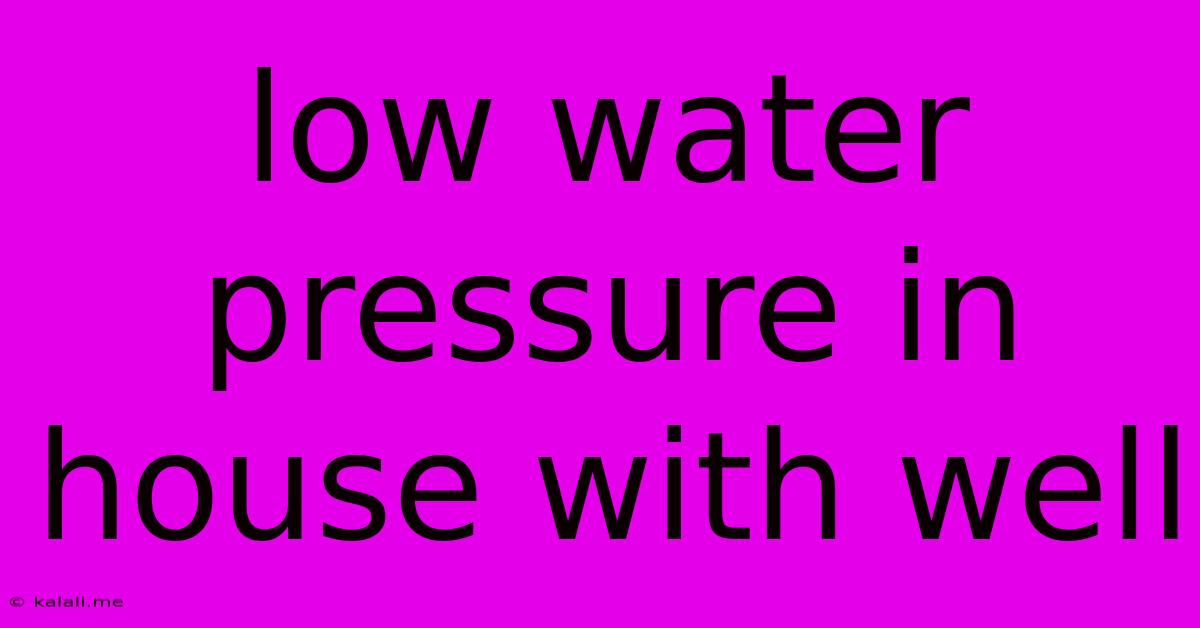Low Water Pressure In House With Well
Kalali
Jun 07, 2025 · 4 min read

Table of Contents
Low Water Pressure in House with Well: Troubleshooting and Solutions
Low water pressure in a house with a well can be incredibly frustrating, disrupting daily routines and impacting household appliances. This comprehensive guide explores the common causes of low water pressure in well systems and offers practical troubleshooting steps and solutions. Understanding the source of the problem is key to restoring adequate water pressure to your home.
Common Causes of Low Water Pressure in Well Systems
Several factors can contribute to reduced water pressure in your home's well system. Identifying the culprit is the first step towards a fix.
1. Well Pump Issues:
- Pump Failure: A malfunctioning well pump is a frequent culprit. This could involve a worn-out motor, damaged impeller, or other internal components. The pump might be struggling to draw sufficient water from the well.
- Low Pump Pressure Switch Setting: The pressure switch controls when the pump turns on and off. An incorrectly set switch might cause the pump to shut off too early, resulting in low pressure.
- Air in the Pump: Air trapped in the pump lines can impede water flow, significantly impacting pressure.
- Clogged Pump Intake: Sediment, debris, or mineral buildup can restrict water intake, reducing the pump's efficiency.
2. Well Problems:
- Depleted Water Table: Prolonged periods of drought or excessive water usage can lower the water table, making it difficult for the pump to draw enough water.
- Well Screen Clogging: Over time, the well screen can become clogged with sediment, reducing water flow into the well.
- Caved-in Well: In some cases, the well casing might collapse, restricting water flow or even causing complete well failure.
3. Plumbing Issues:
- Leaking Pipes: Leaks in your plumbing system, both inside and outside the house, can significantly reduce water pressure. These leaks might be subtle and difficult to detect.
- Clogged Pipes: Mineral deposits, corrosion, or debris can restrict water flow in your pipes, leading to reduced pressure.
- Restricted Water Flow: Kinks, clogs, or improperly sized pipes can impede water flow throughout the house.
- Faulty Fixtures: Low water pressure in a single fixture might point to a problem with that particular faucet, showerhead, or toilet.
4. Other Factors:
- Excessive Water Usage: Multiple household members using water simultaneously can sometimes strain the system, resulting in temporary low pressure.
- Improperly Sized Pipes and Pump: A pump that's too small for your home's water needs or inadequate pipe sizing can cause low pressure.
Troubleshooting Steps for Low Water Pressure
Before calling a professional, try these troubleshooting steps:
- Check the Pressure Gauge: Locate the pressure gauge on your well pump tank. A reading significantly below the normal operating pressure indicates a problem.
- Listen for the Pump: Does the pump run continuously or shut off prematurely? Unusual sounds might signal a pump issue.
- Inspect Pipes for Leaks: Carefully check all visible pipes for leaks, both inside and outside the house.
- Check Individual Fixtures: Does the low pressure affect the entire house or just specific fixtures? This can help pinpoint the problem's location.
- Examine the Well Casing: Check the area around the well casing for any signs of damage or ground settling.
Solutions for Low Water Pressure
Depending on the cause, solutions range from simple fixes to more complex repairs:
- Adjust the Pressure Switch: If the pressure switch is incorrectly set, adjusting it to the manufacturer's recommended settings can resolve the problem.
- Flush the Well and Pipes: Removing sediment and debris from the well and pipes can improve water flow.
- Repair or Replace the Pump: If the pump is faulty, repair or replacement might be necessary.
- Clean or Replace the Well Screen: A clogged well screen needs to be cleaned or replaced to restore proper water flow.
- Repair Leaking Pipes: Repairing any leaks in your plumbing system is crucial for maintaining adequate water pressure.
- Consider a Larger Pump or Tank: If your current system is insufficient for your home's needs, upgrading to a larger pump or pressure tank might be necessary.
When to Call a Professional
If you're unable to identify and resolve the issue after trying these troubleshooting steps, it's best to call a qualified well pump and plumbing professional. They possess the expertise and equipment to diagnose and repair more complex problems, ensuring the long-term health and efficiency of your well system. Remember, addressing low water pressure promptly prevents further damage and ensures a consistent supply of water to your home.
Latest Posts
Latest Posts
-
How To Heat Up Chicken Pot Pie
Jun 07, 2025
-
How To Reverse Trapdoors With Redsrtone
Jun 07, 2025
-
Ge Washer Fills Then Drains Immediately
Jun 07, 2025
-
Groups Cannot Find Name For Group Id
Jun 07, 2025
-
Short Film Womens Eyes Can See Through Objects
Jun 07, 2025
Related Post
Thank you for visiting our website which covers about Low Water Pressure In House With Well . We hope the information provided has been useful to you. Feel free to contact us if you have any questions or need further assistance. See you next time and don't miss to bookmark.